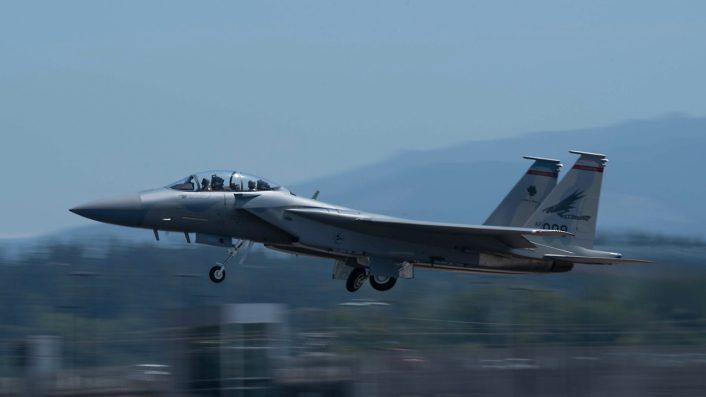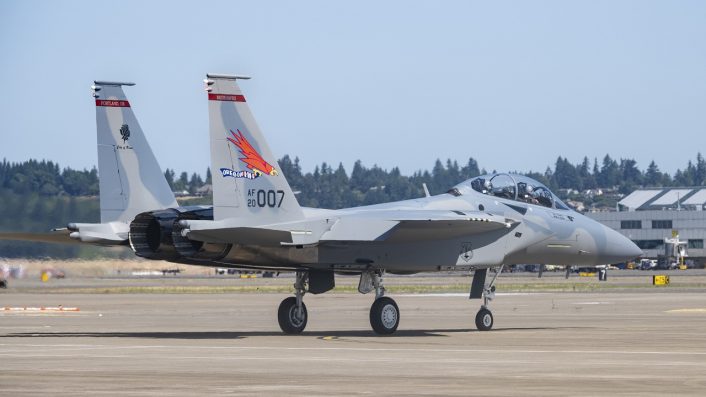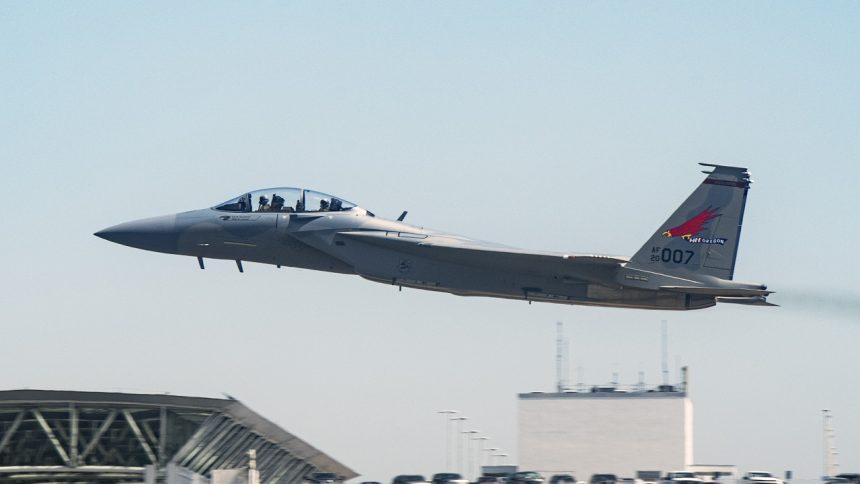The milestone comes with the delivery of the first two operational aircraft to the Oregon Air National Guard.
The new F-15EX Eagle II has finally reached the Initial Operational Capability (IOC) with the U.S. Air Force, as confirmed by Gen. Kenneth Wilsbach, the Air Combat Command’s chief. Gen. Wilsbach announced the milestone on Jul. 10, 2024, while delivering remarks on a webinar hosted by the Mitchell Institute for Aerospace Studies.
Although the IOC was declared a year later than expected dure to production problems, the Air Force planned for a buffer of one year, which ends this month, to reach the milestone. The criteria to be satisfied for the IOC was the completion of the delivery of Lot 1B, which brought the total aircraft delivered to eight.
A couple of days later, on Jul. 12, the Oregon Air National Guard also held an unveiling ceremony for the arrival of the first two F-15EXs at Portland Air National Guard Base. The ceremony, which saw also the attendance of the Acting Air National Guard Commander, Maj. Gen. Duke Pirak, and the Governor of Oregon, Tina Kotek, included a flight of both legacy Eagles and the new Advanced Eagles.
“This momentous occasion marks the first time in history in which an Air National Guard unit has received the very first operational aircraft off the assembly line,” said Gen. Pirak. “This speaks volumes about the Air Force’s interest in parity, lethality and survivability of our Air National Guard across the total force.”
The arrival of the F-15EX in Oregon
As we reported last month, the 142nd Wing at Portland Air National Guard Base received its first F-15EX Eagle II on Jun. 5, 2024, following by the second one on Jul. 2. Notably, the second aircraft delivered (EX-007), is the unit’s new flagship and has received a full color tail flash, while the EX-008 received a subdued variant.
The delivery of the first Eagle II to the Oregon ANG represents the first time a new weapon system is delivered to the Air National Guard before serving in the Air Force. So far, six F-15EXs have been delivered to Eglin Air Force Base, Florida, where they are supporting developmental and operational tests on the new aircraft, while Portland is receiving the first operational examples.

Portland ANGB is expected to receive a total of 18 Eagle IIs by the next two years, which will replace the F-15Cs of the 123rd Fighter Squadron. The 142nd Wing is one of three Air National Guard units set to operate the EX, with the others being the 144th Fighter Wing, Fresno ANGB, California, and the 159th Fighter Wing, New Orleans ANGB, Louisiana.
The Air Force has previously said five F-15C instructor pilots from the 123rd FS conducted training in the F-15EX with instructors from the 85th Test and Evaluation Squadron at Eglin A.F.B. in March. After the first flights, the pilots said they are impressed by the new aircraft, which closely resembles its C-model predecessor externally but it’s entirely different and much improved internally and will inevitably take some getting used to.
The F-15EX Eagle II
The new F-15EX, developed from the F-15QA that was the most advanced Eagle variant, comes from a series of needs mainly emerged after the National Defense Strategy directed the U.S. armed services to adapt to the new threats from China and Russia. The aircraft, while extremely similar to the QA variant, features some US-only capabilities like the new AN/ALQ-250 Eagle Passive Active Warning Survivability System (EPAWSS) electronic warfare and electronic surveillance system and Open Mission Systems (OMS) architecture.
Initially the F-15C/D fleet was to be entirely replaced by the F-22A Raptor, the first 5th gen fighter aircraft of the U.S. Air Force. The service planned to buy 750 Raptors to replace both the F-15 Eagle and the F-16 Fighting Falcon, but that number was cut to 187 production aircraft, which is also less than the about 230 F-15C/D still in service. Because of this, the operational life of the Eagle had to be extended as it was initially scheduled to be retired in 2019.
When the F-15X program, also known as Advanced F-15, was first launched, both a single and two seat variants were proposed, called F-15CX and F-15EX respectively, and both with the same exact capabilities. The Air Force ultimately decided to go only with the two seats variant, which will reportedly have the option to fly with a single pilot or both pilot and Weapons Systems Officer (WSO).
The Eagle II completed last year the Integrated Test & Evaluation (IT&E) Phase I, during which the F-15EX participated in 19 Large Force Exercise events where it integrated with 5th generation aircraft, recorded the longest Air-to-Air Missile employment, and validated the first F-15EX employment of the longest non-nuclear Air-to-Ground munition release in the inventory.

The plans for the F-15EX
The Air Force initially planned to acquire up to 144 F-15EX aircraft, however the number decreased to 104 last year. Earlier this year, the number was reduced even more, with the FY 2025 budget request mentioning the Air Force will buy the last aircraft in 2025 and then end the production, capping the fleet at 98 aircraft.
The FY25 National Defense Authorization Act planned to revert also this decision, with the House Armed Services Committee authorizing $ 271 million in advanced procurement spending for 24 additional aircraft to be added to the FY2026 budget, bringing the F-15EX fleet to 122 airframes.
The markup filed last week by the Senate Armed Services Committee included six F-15EXs, on top of the service’s request for 18, at a cost of $690 million. These aircraft are part of the National Guard Bureau’s unfunded priorities list.
On July 3, 2024, the United States Department of Defense announced a “modernization plan” with the goal of deterring Chinese aggression in the region and strengthening forces in Japan. As part of this plan, 36 Eagle II jets will replace the 48 Eagles which were assigned to the 18th Wing’s 44th and 67th Fighter Squadrons at Kadena Air Base, Japan.
Remarkably, the announcement marks the first commitment of the new F-15EX Eagle II, the most advanced Eagle variant ever produced, to a base outside the United States. A timeline was not released and, given that there already three operational bases waiting for the new jets, Kadena might have to wait or receive new aircraft at a slower rate.









